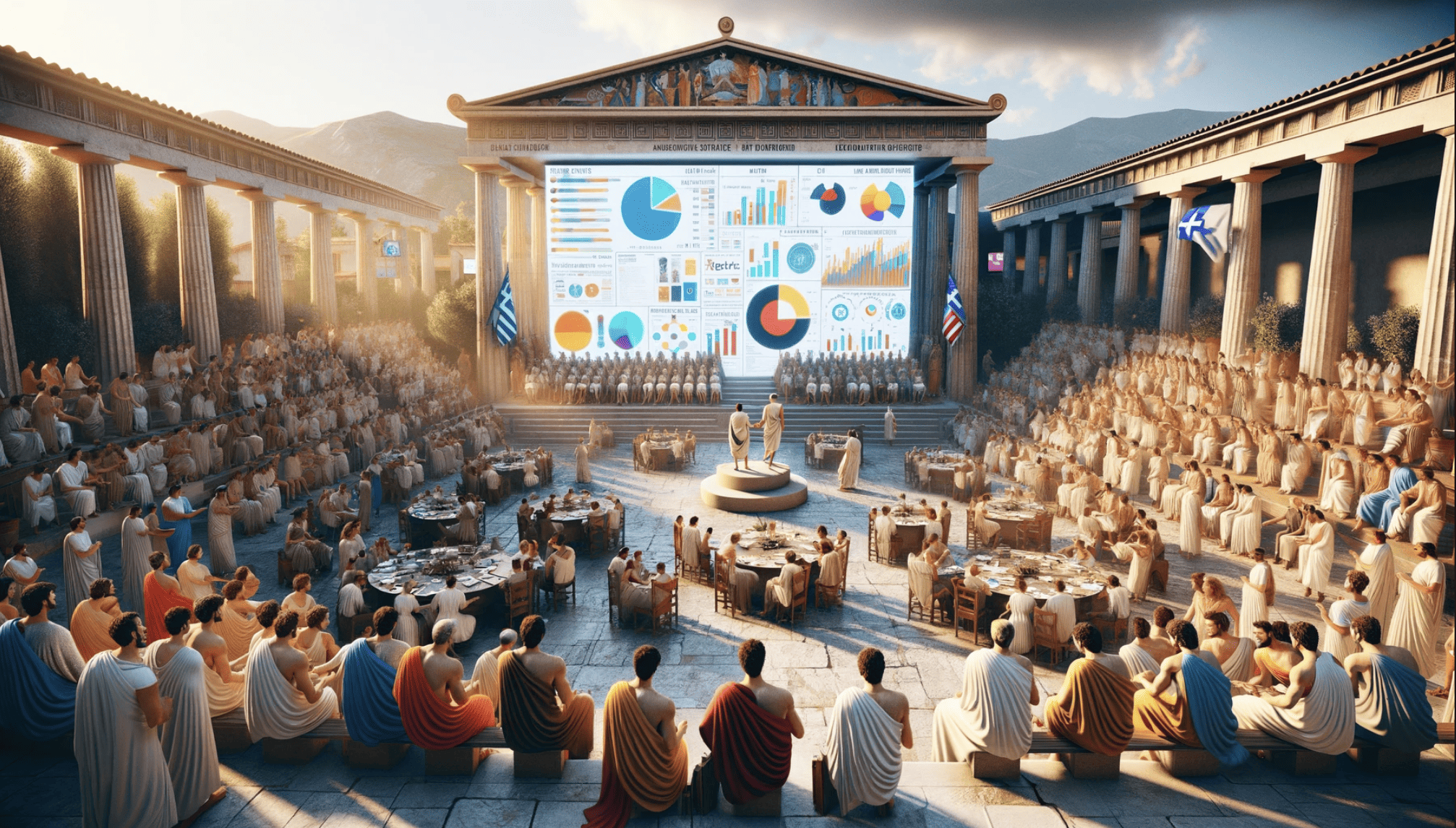
With “Brainwaves“, Eindhoven has seen the first city meeting supported by artificial intelligence (AI). With over 50 participants engaged in 60 different conversations in alternating threesomes, some 20 hours of discussion about the city’s future was held together on Feb. 22. Feedback from participants was mostly positive, despite some technical teething problems. Most people participated in the experiment from home; a small proportion attended at the Dynamo venue, where the organizers were also seated.
How this story came about
Reporting on an event focused on using AI to improve local democracy is an obvious job for Laio, our very own artificially intelligent journalist. For this story, she used Brainwaves’ event report and the event announcement, also created by Laio, as starting points. At the end of this report, Laio shares relevant additional sources and two suggestions for improvement.
Brainwaves and its associated tool Common Ground aim to facilitate open dialogues that transcend the traditional dichotomy between decision-makers and citizens, contributing to a more inclusive and transparent decision-making process.
The AI facilitated, and the brainstorming session resulted in a wish list for the city. The list includes addressing the housing shortage, reducing light pollution and using artificial intelligence to improve the connection between citizens and officials. The event shows the potential of technology to increase engagement and inclusivity in community decision-making. The organizing team is now taking steps to optimize the experience and further encourage participation.
The initiators, led by start-up Dembrane, were inspired by the idea that the most meaningful conversations often occur in informal settings, such as at a coffee machine. The concept of capturing these spontaneous, casual interactions and harnessing them for city deliberation led to the development of Common Ground. This platform allows collecting and analyzing the rich diversity of ideas and opinions within a community. “The challenges associated with societal transitions require us to rethink how we plan and prepare for change. Dembrane aims to contribute to a more connected and engaged community by facilitating open and inclusive conversations. The results and experiences of BrainWaves are an important step in that direction.”

Voice of Eindhoven: the wish list
BrainWaves has distilled a wish list for Eindhoven by combining quantitative and qualitative analyses. This list reflects the shared aspirations and concerns of the participants. Addressing the housing shortage, balancing being a “City of Light” and countering light pollution, using AI to enhance communication between citizens and officials, and improving public transportation are high on the list.
In addition, the importance of accessible green spaces in the city, the involvement of young people in the community, and the creation of non-commercial common spaces are highlighted. These wishes provide a clear understanding of the priorities that resonate among Eindhoven residents and lay the groundwork for future city planning that responds to the real needs and desires of the community. The top-7 desires:
- Explore opportunities to address the housing shortage
- Finding a balance between being a City of Light and fighting light pollution
- Using AI to strengthen the bridge between citizens and officials
- Address the deterioration of public transportation
- Accessible green space as a standard, not an exception
- Improving youth involvement in the community
- Creating shared non-commercial spaces
From success to improvement
Despite the event’s success, the promoters say there is room for improvement. The data quality and teething problems of the AI moderator require attention. The Dembrane Team, the organizer behind BrainWaves, sees this first test as an opportunity to learn and refine the platform. The feedback collected through both the interviews and the feedback forms offers valuable insights into the technical and process aspects that can be improved.
One of the key lessons is that direct, open conversations between citizens provide a wealth of information that might otherwise go unnoticed. This highlights the potential of AI assistance in future participatory processes and the value of digital platforms that encourage inclusive and transparent engagement.

The future of participation
The BrainWaves event is a leap forward for Eindhoven and an inspiration for other cities. It shows the possibilities that technology offers for strengthening democratic engagement. The road to an ideal form of digital civic participation is still long and challenging. Nevertheless, Eindhoven’s experience offers hope and a concrete example of how cities can strive for more inclusive and effective decision-making processes.
With this innovative move, Eindhoven recognizes the value of every resident’s voice. The city is committed to building a future where technology can bridge the gap between citizens and government. This experiment shows that a better future is possible and within reach with the right tools and approach.
The Dembrane Team is looking for new opportunities – in and outside of Eindhoven – to explore the platform’s potential further. “We are already full steam ahead to make complex conversations concrete at scale. On our way to a world where every community has the opportunity to engage in substantive and connecting conversations.”
Addendum: concluding provisions from Laio
Laio created the above article based on the report of the Dembrane meeting. At two points, Laio comes up with related suggestions: additional sources and missing information.
Additional sources
Based on the outcomes of Common Ground, Laio recommends the following additional (Dutch) sources to interested parties:
[1]: https://dembrane.notion.site/BrainWaves-Een-test-van-onze-oplossing-voor-hybride-participatie-a0804b5cc479483f95aa0b96f26252dd
[2]: https://thesis.eur.nl/pub/66452/Rianne-Scheerhoorn.pdf
[3]: https://www.esri.nl/nl-nl/sectoren/needs/gemeenschappelijke-betrokkenheid
[4]: https://ibestuur.nl/artikel/zes-succesfactoren-van-digitale-burgerparticipatie/
[5]: https://www.universiteitleiden.nl/onderzoek/onderzoeksprojecten/governance-and-global-affairs/digitale-innovaties-en-inclusieve-participatie
Missing information
Laio recommends that the organizers come up with additional information in two specific sub-areas:
The information provides a comprehensive look at the BrainWaves event and its results. However, the article would benefit from more detailed data on the demographic composition of participants and the involvement of specific target groups. This is relevant because it may affect the results’ representativeness and the participation process’s inclusiveness. Therefore, my first question would be:
To assess the representativeness and inclusiveness of the BrainWaves session:
Can you provide detailed demographic data on the participants, such as age, gender, ethnicity, and whether specific target groups such as youth or people with disabilities were actively involved?
There is further mention of technical difficulties and the role of AI. Still, it is unclear what specific technical difficulties participants experienced and how the AI was deployed. Understanding the nature of the technical problems and the functionality of the AI can help understand the impact on the user experience and the quality of participation. Therefore, my second question:
To better understand the impact of technology on the user experience, can you provide an overview of the specific technical issues participants experienced and how the AI was deployed during the BrainWaves event?

